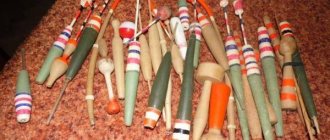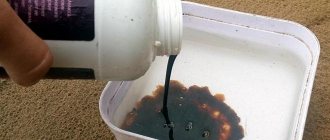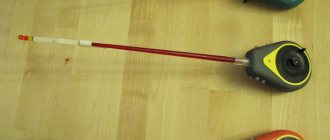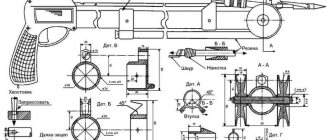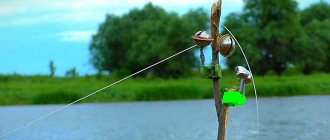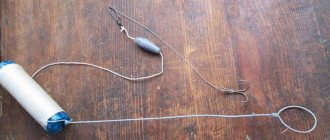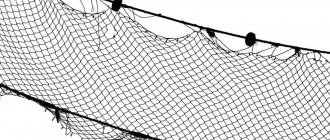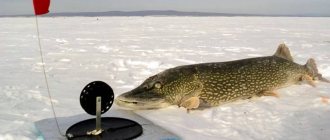Most likely, the harness evolved from the saddle with the advent of spinning rods. These gears are similar in principle of operation, although they are designed for fishing at different depth levels. The attitude of fishermen towards them is also ambiguous - some believe that drag fishing is a poaching method of fishing, and consider its use unacceptable, while others argue that in terms of catchability it is not superior to other conventional gear and at the same time requires skill for effective use. One way or another, fishing with a tug-baler (sometimes this tackle is called that) is sometimes practiced on small rivers. In this case, the baler works most effectively precisely for fish that find food in the surface layers of the reservoir. It is advisable to fish with a partner, however, you can use this gear alone, although this is much less convenient, and limits the maneuverability of the hauling, and can negatively affect the quality of the feed bait
Principle of gear design
The tug tackle is quite simple. It is nothing more than a piece of fishing line wound on the reels of two spinning rods, to which a dozen or more hooks are tied.
The rods carry out all the maneuvers, and if it is necessary to remove the catch from the hook, part of the fishing line is wound onto the reel that is closest to it. Sinkers or foam floats are sometimes used as additional elements - these devices help keep the tackle on the working horizon. But this is true if two anglers are fishing with a tug, but fishing with a bale is possible alone. The tackle differs from the option for two in that a piece of elastic band (round in cross-section or tape, there is no difference) is tied to the end of the fishing line, thanks to which it will be possible to return the tackle to the fishing site.
The animation of the bait is carried out by synchronized lifting of the rods, the equipment is periodically literally hit on the water (baled, one of the names of the gear comes from this method of supplying the bait), primarily attracting predators like chub that feed at the surface.
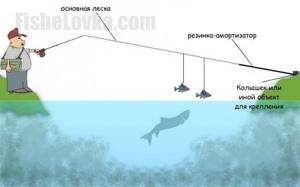
Photo 1. Scheme of the gear operation.
Constriction for one.
A lone fisherman is looking for a bush or tree on the opposite side of the river. He will attach one end of the constriction to it. If there is no necessary support, you can drive a stake into the ground, trying not to make a lot of noise. Then he takes a spinning rod up to two and a half meters long with a reel that has a friction brake. You will need a hundred meters of fishing line. A rubber shock absorber up to five meters long is attached to the end of the fishing line. Its length is chosen to cover the width of the river bed and depending on the quality of the rubber. The fishing line and the shock absorber are usually connected with a metal washer or an ordinary button. Leashes with hooks are attached at a length of 2 meters, and can be extended up to 5 meters. The material of the leash will depend on what type of fish you are fishing for.
Pre-prepared bait. Needs to be saved. While the fisherman swims to the other side to fix the end of the tug. It’s good if there is a ford or bridge, otherwise you will have to use a boat. After the shock absorber is fixed, the fisherman returns to the fishing spot and attaches the bait. Then, thanks to a rubber shock absorber, it ends up in the middle of the river. To attract fish, you need to play with the bait, raising and lowering the tip of the spinning rod. When a fish has swallowed the bait with a hook, the shock absorber allows it to be fished out.
Features of the place of use
Drag fishing is not possible in all bodies of water. First of all, this concerns the size of the river. Too long a fishing line when catching fish by hauling makes it difficult to maneuver the tackle and degrades the quality of bait delivery, and it is difficult to control bites over a long stretch; after all, this is tackle for small rivers.
Important! The length of the rods can to a certain extent compensate for the long fishing distance; the longer the spinning rods, the longer the bale can be used comfortably.
Also, when using a tug for catfish or other fish, you need to select suitable areas of the shore. A lot of aquatic or terrestrial vegetation in the coastal zone easily makes the use of gear impossible. Too much difference in the height of the left and right banks can also worsen the supply of bait.
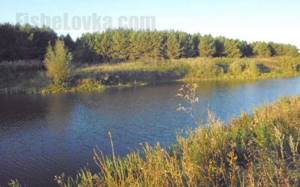
Photo 2. Convenient place for re-tying.
Asp fishing place
The tug tackle is quite simple.
It is nothing more than a piece of fishing line wound on the reels of two spinning rods, to which a dozen or more hooks are tied. The rods carry out all the maneuvers, and if it is necessary to remove the catch from the hook, part of the fishing line is wound onto the reel that is closest to it. Sinkers or foam floats are sometimes used as additional elements - these devices help keep the tackle on the working horizon.
But this is true if two anglers are fishing with a tug, but fishing with a bale is possible alone. The tackle differs from the option for two in that a piece of elastic band (round in cross-section or tape, there is no difference) is tied to the end of the fishing line, thanks to which it will be possible to return the tackle to the fishing site.
How to make a constriction? It's simple. It is enough to wind the fishing line (with a thickness of 0.3 mm or more, depending on the expected size of the catch) onto the spools of two reels so that a certain reserve remains on both. Approximately in the middle of the main monofilament line (although a braided cord is also suitable), leashes begin to be knitted. Their length is selected so that adjacent hooks cannot catch each other.
Fishing by drag has its advantages and disadvantages. The disadvantages include the following:
- Seasonal restriction. Fishing in this way will only be possible during the period of active flight of insects.
- Difficulty in installing gear. The need to throw it from bank to bank makes drag fishing inconvenient for solo fishing.
The article talks about a universal method: catching an asp using a constriction. In what cases is it necessary to use this method, its advantages and disadvantages are considered.
Particular attention is paid to catching asp using this method.
As a child, early in the morning, with the first roosters, I ran out into the yard, where my friend was already waiting for me. Having taken everything we needed, we rode off on bicycles to the river to fish.
To be able to cross to the opposite bank of the river, we fished near the bridge. Arriving at the river at dawn, and each settling down on his own bank, we began to catch very cautious fish.
We fished in an unusual way called “pulling”. We used grasshoppers or dragonflies as bait, which we had previously caught in the meadow while the grass was still wet.
The catches were notable, large and varied fish were caught: chub, asp, ide, rudd and even perch. The river in those places was shallow, and by mid-summer the water was covered with grass, leaving small windows in which we caught our fish.
At that distant time, we knew nothing about fly fishing. We didn’t have long and light fishing rods like we do now, and fishing for asps with a drag seemed to us the most progressive and the most advanced.
We used insects and artificial flies as bait, which indicated the versatility of this type of fishing. Childhood passed, and we gradually began to forget about the “drag” method of fishing.
Hauling is considered a native Russian method of fishing, just like jigs. This method has lost its former popularity, although it still arouses great interest among fishermen.
This method is used during the period of mass emergence of insects. The main advantage of hauling is that with this method you can fish in continuous grass in the most inaccessible places in reservoirs.
They catch not only riding fish in overgrown places in small “windows”, fishing a huge section of the river.
The method is truly universal; you can fish with live bait or an artificial fly. I once observed how on an overgrown forest lake they caught crucian carp using maggots using this method, although crucian carp is a bottom-dwelling fish.
A prerequisite for this type is that two people need to catch it.
To fish by drag, you need to have two spinning rods with inertial reels with a line supply of 70-80 meters and a diameter of 0.4 mm.
The ends of the fishing lines are connected, and instead of connecting, a leash 0.5 to 1.5 meters long is installed from a fishing line with a diameter of 0.25-0.3 mm. The leash should not be longer than the length of the rod.
At the end of the leash you need to tie a single hook. To prevent the leash from twisting between the fishing lines, you need to install a swivel. Usually several leashes are installed, two or more.
Since two fishermen, who will be located on opposite banks, need to fish “by drag,” it is necessary to have a boat.
The fishing tactic is that, being at a great distance from the fishing site, it is necessary to deliver the bait to the cautious fish in places where it accumulates.
The “drag” fishing method is best suited for asp. The asp is a very cautious fish.
The asp’s favorite areas for hunting are rifts and rapids, steep banks or channel currents located far from the shore, places with overgrown grass and reverse flow, as well as snags.
Today, a crossbar is a structure that includes many hooks on which bait is attached. All hooks are attached to a cord or strong fishing line, and its ends are located on the shore, tied to anchors or wooden stakes.
This fishing method allows you to catch a lot of fish in a short period of time; it can be used both in still water and in flowing reservoirs. They are also used in sea fishing, and in this case it will already be classified as fishing gear.
Depending on the bait used, you can catch both carnivorous and herbivorous fish. To use a seine effectively, it should be properly equipped and adapted to a specific fishing area. To do this as competently as possible, you will have to understand the principle by which this gear operates.
And here's what you need to know: FishHungry (Fish Hungry) bite activator
Design
The key design element of this gear is a fairly long fishing line or cord attached to the shoreline. Leashes with installed hooks with bait are attached to it. To connect the leashes to the fishing line, a loop system is used.
This technique has a number of positive aspects, the key of which is the ability to store leashes separately. To prevent them from intertwining with each other, they are fixed at a certain distance from each other.
The length of the leash is selected so that it is slightly less than half the distance between adjacent leashes. If during transportation the hooks and leashes are not removed from the main fishing line, then they are secured in pieces of foam plastic.
If an experienced fisherman uses this gear, then in most cases he will take a reel made of hard foam. You can not only wind fishing line on it, but also hide the tips of even fairly large hooks.
Nets designed for fishing come in various designs.
The classification directly depends on the depth at which the bait will move:
- Bottom – allows you to catch species of freshwater or marine fish that live in the area of the bottom of the reservoir, for example, tench, carp, catfish, burbot, bream and a number of others;
- The middle one helps catch pike, ide, rudd, perch and others. In order for the hooks to move as evenly as possible in the water column, small buoys are additionally attached to them, secured to the main fishing line;
- The horse is designed to catch individuals from the surface layers. Thanks to this equipment, you can easily catch trout, asp, chub and other species.
Operating principle
The gear functions extremely simply. The fish moves from one place in the reservoir to another, meets bait on its way, swallows it and sits on the hook. It’s not too difficult to pull out such fish: all you have to do is get the gear and take the catch.
How to make a saddle with your own hands?
To get the most catchable gear, you need to have a number of materials on hand:
- A wooden block, the length of which will be about ten centimeters. It will be needed to wind fishing line or twine. In principle, you can take a large-sized coil instead. A small recess is cut into the block so that the strap is held on it as tightly as possible and does not slip off;
- Strong rope, fishing line or leash. In this case, experienced fishermen use nylon cord, as it is characterized by good strength and low weight. It will be used during the fishing process as a saddle string. The length of the segment depends on the reservoir, the depth at which it is planned to catch fish, as well as on a number of other factors;
- The fishing line is of small thickness - maximum 0.2 mm. It is used to make leashes. They need to be made in such a way that they do not intertwine with each other and cannot get caught on various types of irregularities if fishing is carried out in the bottom layers of the reservoir. If the pond is not too deep, then the leashes are made no more than half a meter;
- From ten to twenty hooks - their number directly depends on what goals the fisherman is pursuing. In principle, such hooks can be made from nails or steel wire; they must be carefully sharpened, otherwise the catch may break. However, it is much better to purchase finished products, since they are already well-hardened and can withstand quite serious loads;
- Sinkers are used only for bottom casting. There is no need to purchase them in a store; such elements are made from pieces of lead that are attached to a fishing line. A nut or stone with a hole drilled in the central part works well as a sinker;
- Carbines should be taken depending on the number of hooks to be installed. They attach the leashes to the main line. In principle, if you wish, you can do without them; in this case, the leashes are simply tied.
Fishing tactics
The tactics of fishing with a seine means that before going fishing you need to decide on the design of this gear. To do this, you will have to take into account the characteristics of the reservoir - river, lake, pond or reservoir.
Here's what you need to know: Tackle for fishing with live bait from the shore
In particular, if the reservoir has a fairly significant width, then you can forget about installing gear across the current.
To catch a significant amount of fish, you need to choose the right bait. If an angler expects to profit from predatory fish, then it is best to use live bait, the size of which depends on how large the fish are planned to be caught.
If you can use a small minnow to catch perch, then for catfish you need a more substantial bait, the mass of which will be more than a kilogram. When the bottom of the reservoir is muddy, a dead fish is placed on the hook, otherwise the tackle can become very tangled.
Catching fish on the river
Over the past hundred years, the very meaning of the word peremet has changed a lot. Previously, when using the word seine, all fishermen imagined river gear with a rope tied from one bank to the other.
The fishing tackle itself did not necessarily have to consist of only hooks. Today, the word seine means a tackle consisting of a large number of hooks, which can contain a wide variety of bait.
Hooks are attached to a long fishing line or cord, which is tied between two stakes or anchors.
It should be noted that the seine is a very catchy tackle. Fishing with it occurs both in still water (lakes), and on rivers and reservoirs. For example, sea lines are classified as fishing gear. Depending on the bait that will be used by the fisherman, using a net you can catch both predatory and peaceful species of fish.
In order for fishing to take place as efficiently as possible using a net, it is necessary to select the optimal equipment option specifically for a given fishing location. Therefore, you first need to understand the principle of operation of the saddle.
The basis of the seine is a long cord, which is most often tied to stakes driven into the bottom. Leashes with hooks are attached to the base of the cord.
A loop system can be used to connect the leaders to the main line. This method of fishing has its advantages.
This will allow you to store the leashes separately. To ensure that the leashes do not overlap, they must be tied at the required distance.
The length of the leashes should be several centimeters less than half the distance between two fixed leashes. If hooks and leashes are not removed during transportation, they can be hidden in pieces of foam plastic.
Experienced fishermen reel the line onto a foam reel. It is very convenient to hide hook tips in polystyrene foam.
Fishing harnesses can have different designs. Everything depends, first of all, on the horizon where the bait is located.
- Donny. This design allows you to catch bottom fish species, such as tench, carp, carp, pike perch, catfish, burbot.
- The hooks of the tackle are located in the middle layers of the water area. Good fishing for pike, perch, ide, sabrefish and rudd. To ensure that the hooks are located in the water column, you can use buoys or floats that are attached to the main cord.
- Horse transfer. Located above the surface of the water area. The hooks are equipped with insects. Using this design, fishing for asp chub and trout is very successful.
Before starting fishing, the angler must decide on the design of the tackle, which depends on the fishing location, the characteristics of the reservoir and the types of fish that the angler wants to catch. For example, if the reservoir is wide, then it may not be possible to set a line across the current.
The reel is an ancient device for catching large freshwater fish, which is still used today. To make it, you basically only need rope and hooks. This article will talk about how to make a saddle yourself.
What is a shift? Saddle design
A peret is a tackle that consists of a long rope stretched between two fastenings and equipped with many hooks with bait attached to them. Most often, fencing is used in rivers, but it can also be constructed in lakes or reservoirs. Large-sized nets are called longlines and are intended for sea fishing on an industrial scale.
For fishing on a small river, an interesting tackle called a tug has been used for a long time. It allows you to catch different types of peaceful and predatory fish that feed at the surface of the water.
The article talks about the universal method of catching fish “by dragging”. In what cases is it necessary to use this method, its advantages and disadvantages are considered.
At that distant time, we knew nothing about fly fishing. We didn’t have long and light fishing rods like we do now, and catching fish “by drag” seemed to us the most progressive and the most advanced.
They make a draw from two spinning rods. One end from one coil is connected to the other end on the other coil. The fishing line used is 0.35 mm in diameter, transparent. An alternative to fishing line can be braid with a diameter of 0.18 to 0.2 mm with a breaking load of up to 8 kg.
And here's what you need to know: How to catch burbot in winter using a snitch
As you can guess from the name, the tackle consists of two paired spinning rods equipped with inertial reels. One or more leashes with bait in the form of fresh insects are attached to a common fishing line. Grasshoppers, butterflies, locusts, and dragonflies are used as bait. If you plan to catch predatory fish, use live bait.
The process of making a bale does not require special skills and is carried out directly at the fishing site.
Before fishing begins, anglers are located in their positions, on different banks of the reservoir, within line of sight. Next, one of them throws, or (if possible) transports his line and sinker to the other side of the river.
The second fisherman removes the sinker and both lines are tied together. Leaving a knot connecting both lines approximately in the middle, one of the anglers ties several, usually 2-3, leashes.
As such, pieces of fishing line with a diameter of approximately 0.18-0.25 mm are used. Hooks are attached to the ends of the leashes.
The tackle is ready.
Scheme of rigging for haul fishing
Correct rig position when playing with a fly
Second stage of gear setup
Scheme for fishing in a wade using a constriction
What kind of fish can be caught this way?
A bale is most effective when catching fish that feed primarily in the surface layers of a reservoir (although catching catfish by dragging is also sometimes practiced). First of all, these are the so-called “white predators” - chub and asp. In mountain rivers you can catch trout using this method. Among the peaceful fish that are caught on the hooks of the constriction are redfish, rudd, and saberfish.
To a large extent, species diversity depends on the bait used and the depth of fishing. Grasshoppers, various other insects and their larvae increase the likelihood of catching a chub, and if there is live bait on the hooks, then you can count on catching a pike or large perch. Well-coordinated teamwork and competent maneuvering of tackle with additional weight allow you to fish at depth. Reeling for catfish can also be used - to do this, you need to add a sinker to the tackle, and use frogs, leeches, or large bunches of crawlers as bait.
Retightening: unusual tackle for fishing
22.04.2016Even in ancient times, fishing on small rivers was often carried out with the help of a cunning tackle called a tug. It is very effective for surface fishing and allows you to catch different types of fish.
A tug, also known as a bale, is used when insects begin to appear above the surface of the water, attracting fish. This is an old tackle, simple and versatile. Even a beginner can assemble a tug, and there are two options for it - for single fishing and for doubles (but this requires good coordination). If there is silence on the shore, this tackle will bring an excellent catch, and our ancestors had enough of this for food and trade. There are quite a few models of constrictions, including even the most modern modifications.
Classic tug
Several centuries ago, even such words as feeders or spinning rods were unknown. However, our ancestors used much simpler gear to catch excellent fish. The gear of those times was very simple to make - all that was needed was rods, fishing line and hooks. Moreover, hooks were in real short supply, and the gear was made in such a way as to minimize the possibility of breakage. The tug is just that - a successful invention that has survived many generations of fishermen.
This is how tugging was done in ancient times - a thick fishing line (or rope) was taken, folded in half and tied securely. This ring was fixed on both banks of the river, and was intended for small reservoirs. The typical line length was only 2-3 meters. The leashes came off from her, often the hooks on them were homemade. In principle, this is all the gear - there were no floats, no weights, no rods on it. The hooks caught bait, primarily insects. Sometimes worms, bloodworms, or even fry were used to replace them. Most often, two people fished with a tug - the second fisherman moved to the other bank and secured or held the end there with his hands.
Modernized drag
With the advent of spinning rods and reels, the simple idea of drag was slightly modernized. In principle, this design option is most often found in literature and in practice, although it is quite young, it is only about a hundred years old. This type of gear is also easy to make.
For it, two ordinary spinning rods are taken with a length ranging from 2.1 to 2.7 m, sometimes less. Inertial coils are placed on them, they are also “meat grinders”. The fishing line for both of these spinning rods is the same, with a thickness of 0.3 to 0.4 mm. One half is wound on the drum of one spinning rod, and the second on the reel drum of the second. Moreover, both reels should have enough fishing line, greater than the width of the river. You also need to not just wind the fishing line, but thread it through the guide rings on the rod. As a result, there will be two spinning rods on one line, and one will be used for fishing.
The area between the spinning rods, which will be above the river, serves to secure the leashes. To do this, loops are made on the main line - 5 pieces, no more. Under the leashes there is a fishing line about 0.2 mm thick, monofilament. It must withstand the jerks of large fish weighing at least 3 kg - if the fishing is for asp and similar fish. And for large pike you will need steel leashes with powerful hooks.
Hauling for one fisherman
If there is only one fisherman, he can also fish with a drag. It's just that the opposite end is securely attached to something - a tree, a root, etc. If the other bank is completely empty, you can simply drive a stake into the ground and attach the tackle to it.
A single haul is done according to the double principle - you will need a spinning rod with a length of 2.1 to 2.4 m, a reel equipped with a friction brake, and up to one hundred meters of thick fishing line, 0.3-0.4 mm. Its end is additionally cushioned with a piece of rubber about 5 meters long. Usually the rubber shock absorber and the main line are connected through something intermediate - for example, a metal washer. This connecting element is already close to the water. And a few meters from it, leashes are mounted on the main line. Their choice depends on the fish being hunted in this particular body of water.
Fishing technique for one person
It’s not particularly difficult to catch one by one, but for this you need to prepare in advance. Firstly, you need to find a good bait that is relevant to the fish being caught. It is placed in a safe place on one bank (precisely the one from which fishing will then be carried out), the spinning rod is well secured there, and its reel is placed in a free position. Then the fisherman needs to go to the other shore with the end of the fishing line in his hand - either by swimming or across a bridge, if there is one nearby. On the other side, a rubber shock absorber will act as a “fisherman” - you need to secure it well, and only then return to “your” side, for direct fishing.
To set the bait, the fisherman simply winds the line around his reel until the leaders are pulled in—this puts a lot of tension on the elastic. Then, when all the baits are placed on the hooks, the line is released and the rubber pulls the leads into the middle of the river. With this gear, it is quite possible and necessary to perform some kind of game, just raise and lower the rod tip from time to time. This is great for attracting the attention of fish. When the fish has bitten, it is possible to do both hooking and retrieving. In this case, the rubber shock absorber will stretch greatly, which will allow you to bring the fish directly into the landing net. After this, the bait is attached to the hook and sent back into the water to work below the surface.
Fishing together
It’s easier and faster to fish with a tug together, and there’s a much better chance of noticing a bite in time. If the river is quite wide, this significantly speeds up fishing.
Of course, success requires good organization and definition of roles. One person will be engaged in fishing, and the other will play off the fishing line at this time. It also makes sense to play the game only for one fisherman. All situations need to be discussed and thought through in advance, and if the need arises, it is better to communicate with gestures, since fish during surface fishing are very sensitive to any noise. Heckling fishermen across the river will simply scare her away.
Fishing begins with unwinding - one fisherman stands on the shore with a weakened reel, and the second must move to the other shore with his spinning rod. When everyone is in their place, it is time to extend the leashes into the middle of the river. The big advantage is interchangeability - it’s easy to change roles, the tackle is equal on both sides. For example, after each catch, fishermen can change, and another one will attach the bait and fish it out.
Modern spinning anglers very rarely fish this way. However, dragging can be a real boon when targeting very wary fish on the surface. In this case, the prey is located in the very middle of the river, and the classic bait for tugging is live insects, frogs or whitebait. When using a tug according to all the rules, there will be a lot of bites - after all, the fish will not be afraid of either the sinker or the float. There is nothing superfluous in this wonderful tackle - just a fishing line, a hook and bait. If you behave quietly and carefully, the catch will be even better than when fishing with the most expensive and equipped spinning rod.
Requirements for fishing rods and other elements of tackle
How to make a constriction? It's simple. It is enough to wind the fishing line (with a thickness of 0.3 mm or more, depending on the expected size of the catch) onto the spools of two reels so that a certain reserve remains on both. Approximately in the middle of the main monofilament line (although a braided cord is also suitable), leashes begin to be knitted. Their length is selected so that adjacent hooks cannot catch each other.
Important! It is worth tying hooks of different numbers, so the catch may include both large predators and relatively small peaceful fish like rudd and perch.
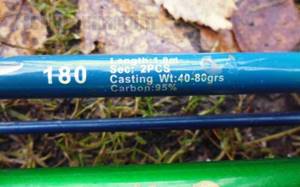
Photo 3. Suitable spinning rod test.
Spinning rods for catching chub on a constriction are needed with a margin of safety; ultralight rods, just like trout rods, are not suitable for baling. But cheap Chinese telescopic options can be used, because the requirements for the ringing of the form are minimal.
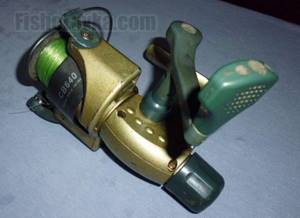
Photo 4. Reel from Chinese comrades.
You can fish with any reel. Both inexpensive inertia-free and old inertial models are suitable. The reel here is needed primarily for storing fishing line; high-quality laying of thin braids is not needed with this method of fishing, so the most budget options are quite sufficient.
When fishing alone, instead of a second spinning rod, you will need a piece of elastic, like the one used in the tackle of the same name.
Elements of constriction
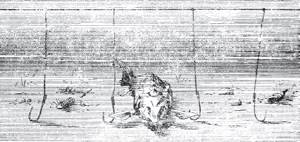
They make a draw from two spinning rods. One end from one coil is connected to the other end on the other coil. The fishing line used is 0.35 mm in diameter, transparent. An alternative to fishing line can be braid with a diameter of 0.18 to 0.2 mm with a breaking load of up to 8 kg.
For each section of the river, the location of the leashes on the fishing line is determined. It is better to use a fragment, as when fishing with an elastic band. On this fragment leashes with a length of 0.35 to 1.5 meters are knitted. The distance between the leashes is 1/3 greater than their length. The diameter of the leads is 0.2-0.3 mm. If we catch small medium-sized fish, then hooks No. 4-7 are suitable, and for large fish No. 6-10. It is better to use hooks with a long shank. If the fish is not very whimsical or, on the contrary, carefully removes the bait, then we install small tees.
Carbines are tied to the ends of the fragment. We knit up to 5 leashes on a fragment. After determining the fishing distance, we fasten the leashes to the fishing line using the carabiner-in-a-loop method. At the ends of the fishing lines we knit loops into which carabiners are fastened.
Baits used
Drag fishermen use mainly baits of animal origin. It can be:
- red dung worms;
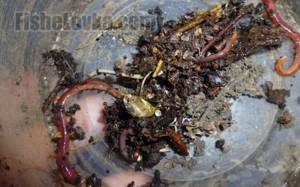
Photo 5. Appetizing worms.
- maggots;
- grasshoppers;
- chafers;
- leeches and frogs;
- fish fry.
Some fishermen also argue that fly fishing flies can be a very effective attachment for a bale, but in this case it is advisable to know how to tie them yourself, because these baits can cost a lot in fishing stores.
Fishing with a drag for two or alone
It is most convenient to fish with a bale together with a partner. One fisherman on a boat crosses the river along a bridge, or wades or swims along with his piece of gear. Next, the fishing line is pulled over the water in promising areas of the reservoir, and the tackle is periodically immersed or raised. With well-coordinated teamwork, the moment the bait touches the water, they look as natural as possible and provoke even such a cautious fish as a chub to attack.
After fishing one point, you can smoothly move up or downstream, thus covering a significant area. With a good knowledge of the bottom topography, as well as with additional weight, you can play with a tug in the water column, as well as at the very bottom, thereby provoking the inhabitants of the near-bottom layers to bite.
Chub fishing can also be done from boats, which increases the maneuverability of the gear and makes it possible to fish promising sections of rivers. However, such fishing requires stable swimming equipment, otherwise it is difficult and dangerous to maintain balance while standing on a single-seat inflatable and at the same time work with the tackle. That is why this method of using constriction is not very popular.
You can also fish with a bale alone. This is somewhat more difficult, and the maneuverability of the gear is lost, but it is possible. To do this, you need to secure a fishing line with a piece of elastic band tied to it on the opposite bank (to a tree trunk, or to a peg driven into the ground). Otherwise, solo fishing with a tug is the same as with a partner, but in order to change the place where the tug is used, you will have to swim across the pond again and tie it in a new place, which will take a lot of time.
What is peremet
Predators were caught using a line back in ancient times; nowadays this tackle is known only to a select few. It is classified as a passive type of fishing; the net is collected, set out and checked after 2-8 hours. A simple hook tackle consists of a base to which a sufficient number of leaders are attached.
This gear is not allowed everywhere; during the period of the spawning ban, it is strictly forbidden to place the lines on any reservoirs . The rest of the time, before you go fishing, it is advisable to find out all the information about it. In some regions it is possible to fish using this method, but under certain conditions. The subtleties of the process are as follows:
- It is strictly forbidden to leave hooks bare; fish swimming by can easily be injured;
- placing more than 10 hooks is not allowed anywhere; the best option is a line of 5-7;
- The longitudinal line for pike is formed from durable materials, and it must be positioned in such a way that a predator does not take the tackle into snags or reeds;
- A good option would be a crossbar that is attached to pegs on opposite banks of the reservoir.
Properly assembled gear and placed in the right place will help you catch a decent-sized pike in this simple way.
Similar tackle - saddle
Sling and drag are sometimes confused, and in some regions these tackles are called the other way around. But it is generally accepted that the seine is distinguished by the presence of floats, sinkers, and also by the fact that it is a passive method of fishing - the tackle is simply fixed so that it remains buried to a certain depth. The bait is often live bait, a bunch of crawlers, leeches, and other options that can interest large river predators like catfish, pike or pike perch. The main difference lies primarily in the fact that the line is always under water in one position, while the drag is constantly moved by anglers, both when changing the fishing point and during retrieving.


